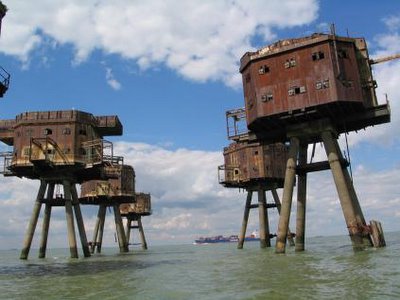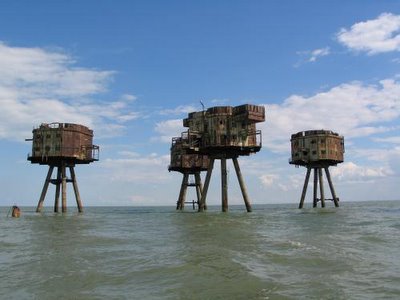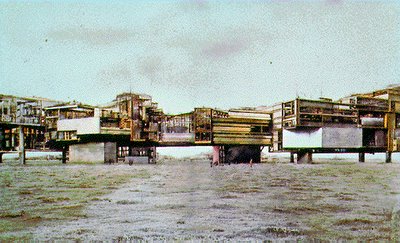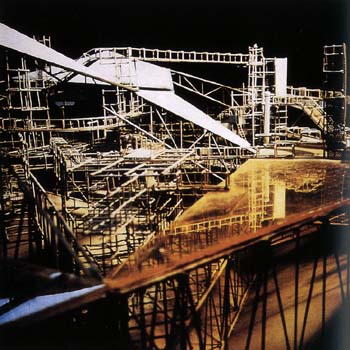Buttressed buttresses
First, whenever I hear the phrase 'buttressed buttresses' I think of Boutros-Boutros Ghali. Perhaps to his credit.
Second, the actual point in bringing up (inventing?) the phrase, is that even buttresses can have buttresses. Buttresses, the spidery, ribcage-like stone arches that stand outside cathedrals and hold up the walls of the nave, have always fascinated me, both on the aesthetic level (they're gorgeous, and absolutely beautiful to look at in their hypnotic repetition and grace) and on the intellectual level. They are, after all, fun to think about it: because they're not really objects, they're events. They're events of gravity channeled downward toward the earth's core; they're the building always on the verge of falling apart – and then not falling apart.
They're somewhere between event and structure.
But what really interests me is to think that you're visiting Paris, say, or some other city that has no name and, strangely, no one's ever heard of it, and you're standing in the apartment of a friend. There's a rather large arching stone structure that cuts through the center of his bedroom, but he's done his best to adapt to it: there are pictures, maybe some cool decorative objects, maybe some shelves, all attached with nails into the arch. You say, 'What exactly is that thing, anyway?' and he grins, embarrassed, and he says, 'It's a buttress.'
You go, 'What?' and hold back a yawn, looking around for a place to sit.
He starts laughing. He says, 'Come on, dude, you know what a buttress is. It's like those – those big fucking things you see outside Notre-Dame. Those spidery, ribcage-like stone arches that stand outside cathedrals.'
'Oh,' you say. 'So... what's it doing in your apartment?'
It turns out, as the man explains, you friend, standing there looking at you with a beer in his hand, that there's a monumental structure in the center of the city, a derrick-like core of platforms and offices, and it's called, simply, The Cathedral. Or The Tower. But it's big, so big, so incomprehensibly massive, that the only way it can remain standing is to surround itself with massive buttresses that help distribute the gravitational load. The buttresses themselves, on the other hand, are so huge that they were put to dual use almost immediately as motorway bridges and highway flyover supports; but then the weight of the motorways, and of cars and trains and people and maybe some houses built atop the buttresses – and, of course, the weight of The Cathedral itself – was all too much, and the buttresses needed to be buttressed. But, as you can imagine, even these subsidiary buttresses were so huge that they, too, were put to dual use; and so on.
Finally, in an exquisite filigree stretching everywhere throughout the city, a mandala of lace-like interconnected structures that spans the width and breadth of the whole metropolis: there begin to appear thousands upon thousands of microbuttresses, all buttressing the buttresses that buttress the buttresses.
And what you see there in your friend's apartment is one of those microbuttresses.
Buttressed buttresses.
There are pubs in the city set in the vertices of two dozen arches; new children's games invented to incorporate the presence of strange structural blocks; and there are dreams at night, shared by everyone, at different times, that even The Cathedral in the center of the city is itself a buttress, and it, too, is just one structural unit among uncountable hundreds of thousands, all of which add up to some dizzyingly titanic megastructure no one has ever seen the whole of.
My point is not to write a science-fiction novel – though I might, actually, so be prepared – but to explore the idea that even buttresses have buttresses; even foundations have foundations; even arches need arches to support them. Even one buttress, after all, requires the resistance and strength of the ground it's anchored upon; and that ground depends upon the strength of the ground around it. Which makes earthquake faultlines so interesting, as an architectural consideration, but that's for another entry.
But the chain never ends. Buttresses simply make visible the always present gravitational forces so well disguised by other styles of building, and, as such, they're amazing.
What would be even more interesting, perhaps, is: you are out walking in a field and you stumble upon a strange architectural structure, only it has no doors or windows, ie. no inside. You're twenty, thirty miles away from any metropolitan center, and you have no clue what it is. You're in a bad mood. You begin to hack away at it, and then finally you just say fuck it, and you drive a Hummer into it. It falls over.
You think that's the end of it, but then you hear that a cathedral has collapsed in the nearest city, and it collapsed because suddenly one of its outer buttresses gave out. It turns out that, yes, the now-collapsed buttress was reliant upon the compressive and resistant capacity of the soil it was anchored in, and that that structure you knocked over, thirty miles away, was very carefully calibrated as a brace for that soil. By knocking it over you let the earth sag, in a straight line leading right to the cathedral, and voilà: architectural action at a distance.
It's the magical mystery of buttressed buttresses.
Second, the actual point in bringing up (inventing?) the phrase, is that even buttresses can have buttresses. Buttresses, the spidery, ribcage-like stone arches that stand outside cathedrals and hold up the walls of the nave, have always fascinated me, both on the aesthetic level (they're gorgeous, and absolutely beautiful to look at in their hypnotic repetition and grace) and on the intellectual level. They are, after all, fun to think about it: because they're not really objects, they're events. They're events of gravity channeled downward toward the earth's core; they're the building always on the verge of falling apart – and then not falling apart.
They're somewhere between event and structure.
But what really interests me is to think that you're visiting Paris, say, or some other city that has no name and, strangely, no one's ever heard of it, and you're standing in the apartment of a friend. There's a rather large arching stone structure that cuts through the center of his bedroom, but he's done his best to adapt to it: there are pictures, maybe some cool decorative objects, maybe some shelves, all attached with nails into the arch. You say, 'What exactly is that thing, anyway?' and he grins, embarrassed, and he says, 'It's a buttress.'
You go, 'What?' and hold back a yawn, looking around for a place to sit.
He starts laughing. He says, 'Come on, dude, you know what a buttress is. It's like those – those big fucking things you see outside Notre-Dame. Those spidery, ribcage-like stone arches that stand outside cathedrals.'
'Oh,' you say. 'So... what's it doing in your apartment?'
It turns out, as the man explains, you friend, standing there looking at you with a beer in his hand, that there's a monumental structure in the center of the city, a derrick-like core of platforms and offices, and it's called, simply, The Cathedral. Or The Tower. But it's big, so big, so incomprehensibly massive, that the only way it can remain standing is to surround itself with massive buttresses that help distribute the gravitational load. The buttresses themselves, on the other hand, are so huge that they were put to dual use almost immediately as motorway bridges and highway flyover supports; but then the weight of the motorways, and of cars and trains and people and maybe some houses built atop the buttresses – and, of course, the weight of The Cathedral itself – was all too much, and the buttresses needed to be buttressed. But, as you can imagine, even these subsidiary buttresses were so huge that they, too, were put to dual use; and so on.
Finally, in an exquisite filigree stretching everywhere throughout the city, a mandala of lace-like interconnected structures that spans the width and breadth of the whole metropolis: there begin to appear thousands upon thousands of microbuttresses, all buttressing the buttresses that buttress the buttresses.
And what you see there in your friend's apartment is one of those microbuttresses.
Buttressed buttresses.
There are pubs in the city set in the vertices of two dozen arches; new children's games invented to incorporate the presence of strange structural blocks; and there are dreams at night, shared by everyone, at different times, that even The Cathedral in the center of the city is itself a buttress, and it, too, is just one structural unit among uncountable hundreds of thousands, all of which add up to some dizzyingly titanic megastructure no one has ever seen the whole of.
My point is not to write a science-fiction novel – though I might, actually, so be prepared – but to explore the idea that even buttresses have buttresses; even foundations have foundations; even arches need arches to support them. Even one buttress, after all, requires the resistance and strength of the ground it's anchored upon; and that ground depends upon the strength of the ground around it. Which makes earthquake faultlines so interesting, as an architectural consideration, but that's for another entry.
But the chain never ends. Buttresses simply make visible the always present gravitational forces so well disguised by other styles of building, and, as such, they're amazing.
What would be even more interesting, perhaps, is: you are out walking in a field and you stumble upon a strange architectural structure, only it has no doors or windows, ie. no inside. You're twenty, thirty miles away from any metropolitan center, and you have no clue what it is. You're in a bad mood. You begin to hack away at it, and then finally you just say fuck it, and you drive a Hummer into it. It falls over.
You think that's the end of it, but then you hear that a cathedral has collapsed in the nearest city, and it collapsed because suddenly one of its outer buttresses gave out. It turns out that, yes, the now-collapsed buttress was reliant upon the compressive and resistant capacity of the soil it was anchored in, and that that structure you knocked over, thirty miles away, was very carefully calibrated as a brace for that soil. By knocking it over you let the earth sag, in a straight line leading right to the cathedral, and voilà: architectural action at a distance.
It's the magical mystery of buttressed buttresses.













